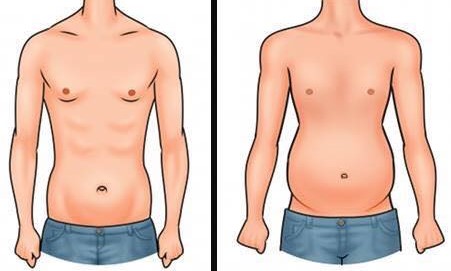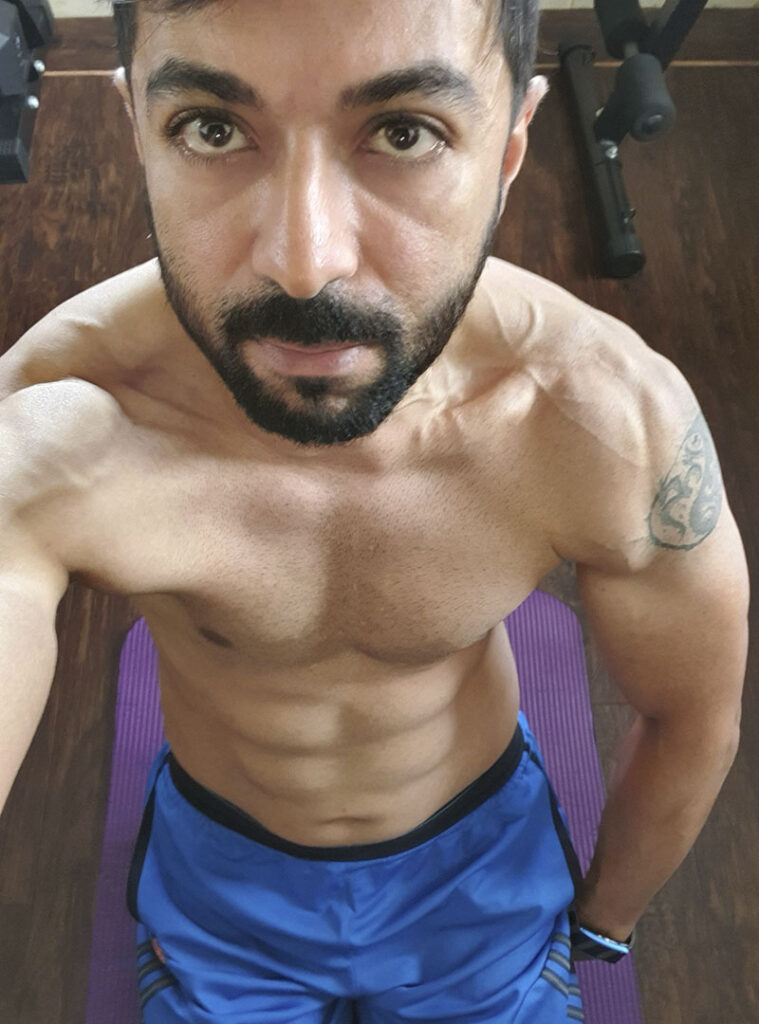
When I started my fitness journey several years ago, I was skinny fat and I remained this way for the longest time. I couldn’t really figure out how to shake it off and get out of it.
If you find yourself skinny fat, I can tell you, via my own experience that not only is it a fixable solution. You can fix it fast, if you do the right things.
First of all, skinny fat is not a body type. It is a condition where you look skinny with clothes on and when the clothes come off, you have that layer of fat around your body’s midsection. So, when we’re talking about skinny fat, we’re looking at a situation where you sort of look like this – you’re both skinny and you’re fat.
Let me explain this a bit differently.
You lack muscle and you still maintain some fat around your midsection. For men – particularly around their waistline, and for women – around their hips and thighs. You’ve got skinny arms, maybe skinny legs, no chest, probably no abs, but you have midsection fat. Basically, what it means is you have low muscle mass and a high body fat percentage.
In this article, I’m going to share with you what actually helped me come out of being skinny fat. I’ll provide you with a clear picture of how you should workout and what you should be eating to overcome the skinny fat problem.
The reasons for being skinny fat could be bad food choices, over-eating or excessive cardio, especially steady-state cardio. I’m not going to do a deep-dive into WHY you’re skinny fat. I’d like to focus instead on the solutions to come out of it.
THE SKINNY FAT TRINITY:
Our goal should always be to improve our body composition, and this can only be done by increasing overall muscle mass and decreasing body fat. The more lean muscle mass you build, the easier it will be for you to decrease body fat stores. The aim is to look lean and athletic throughout the year.
The skinny fat solution boils down to three basic factors. Workout, Nutrition and Sleep I’m going to address all three.

We’ve got two choices to attack this – you can either opt to attack your fat problem and try to get skinnier. However, I wouldn’t advise that because when you do, you end up looking like this – that doesn’t look so good.
This just means that you’re just a very skinny person.
The base of what’s happening in a skinny fat person is a lack of muscularity. There’s no muscular development. So, my second recommendation, is to ensure that you build muscle to start fixing this problem.
Let’s talk about nutrition.
This is THE most important factor. Your first step should be to find your maintenance calories . These are the amount of calories you would consume on a daily basis that would lead to no net gain or loss of weight, based on your average total daily energy expenditure.

The thing to understand about your diet and being skinny fat is that you are not HYPOCALORIC, or you’re NOT in a caloric deficit – meaning that you are NOT consuming less calories than your maintenance calories.
Why do I say this?
Because if you were consuming LESS calories than your maintenance, you would lose the body fat that still remains around your midsection, after burning that fat as fuel.
What it means for someone who’s skinny fat is that they’re still accumulating too many calories from all the foods that they’re eating. So, let’s start from that point, and figure out a game plan.
From a nutrition standpoint, the fact that I know you’re not hypocaloric means you’re at least at maintenance – if not in a caloric surplus. This means, you’re in a good enough state to build muscle.
But ensure you’re only in a minor surplus, like 200-300 calories above your maintenance levels.
Meaning, if your maintenance calories are 2,000 – then you should NOT be consuming more than 2,200-2,300 calories per day.
Now, you might come across people who would tell you that you can eat sweets and junk if you are looking to gain muscle. No! Please don’t fall for dirty bulking. Doing this will mostly increase your fat and not muscle.
Conversely, if you want to eat in a caloric deficit and be hypocaloric and stay under your maintenance levels, that’s fine! Because we know that you can build muscle at the same time that you’re losing fat in a caloric deficit as long as your protein content is high enough – especially when you have extra body fat on you.
If you’re in that range and you’re slightly hypocaloric, let’s say 200, 300 calories below your maintenance levels, you’re still going to be able to add muscle mass, although at a much slower rate. Meaning if your maintenance is 2,000 calories, and you want to be in a deficit, then consume around 1,700-1,800 calories – but not lower.
So, in both scenarios – whether you’re in a slight caloric surplus, being HYPERcaloric, or in a slight caloric deficit, being HYPOcaloric – you can gain muscle both ways – it’ll just be a bit slower being in a deficit versus surplus, but the fat loss will be a bit faster being in a deficit versus surplus.
The KEY bit in both scenarios, however, is the amount of protein you are consuming.
Protein is the most important macronutrient when you are looking to gain muscle. And this needs to be at least at 0.8g per pound of body weight or 1.76g per kg of body weight. Meaning if you’re a 70kg or 154-pound individual, you need to be consuming at least 123g of protein per day to allow for muscle protein synthesis to happen easily.
Generally speaking, keep your meals high in protein, and well-balanced with complex carbohydrates and healthy fats. Try and avoid processed carbs and refined sugars as much you can. Eating a clean and balanced diet will help you achieve these results the fastest.
What I recommend is simply counting your protein content in grams for a day or two. If you’re feeling adventurous – try doing it for a week. We generally eat around the same things almost every single day, so a few days should be plenty to give you an average estimate of how much protein you’re consuming daily.
I’m not asking you to start tracking your macros religiously long-term, rather just for your own awareness it might help you to see how much protein you’re currently taking in. Because if you’re not at that 0.8 grams per pound or 1.76g per kg of body weight right now, you might be surprised at how far below that level you are.
My recommendation to ensure that you’re getting the building blocks to build muscle, is just to take OUT some of your carbs and SWAP them for protein. This is easy as carbs and proteins have identical caloric values. Meaning – 1g of protein is the same as 1g of carbs, in terms of calories – which is 4 calories, so you can make an easy swap between the carbs for proteins. This allows you to stick to exactly the same number of calories you’re currently consuming, without changing your calorie consumption.
Nutritionally this is good enough to get you out of the skinny fat conundrum. Click here to find out what else will help


